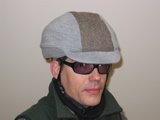Albert Hofmann
The Times today reports that Albert Hofmann, the “father of LSD,” “died Tuesday at his hilltop home near Basel, Switzerland.”
Godspeed Dr. H., and may your hope that one day your “problem child” be treated by modern society in the way that that primitive societies treat psychoactive sacred plants—ingested with care and spiritual intent—come to fruition.
I’ve read Dr. Hofmann’s book, LSD: My Problem Child, and I found it a thoughtful, clear-headed, and somewhat ambivalent reminiscence of his experience as the person who discovered the most powerful “mind-manifesting” drug of the 20th century. It’s a shame that the good doctor’s approach to use of LSD—essentially he advocated its use under controlled conditions of respect for the substance and the person ingesting it—didn’t become the dominant model.
If so, we might be able these days, to take a three-day retreat to some sort of spiritual center in the woods or by the ocean for the opportunity to gaze inward via the unique effects of synthesized extract of the ergot fungus and, as Dr. Hofmann put it, become “aware of the wonder of creation, the magnificence of nature and of the animal and plant kingdom.”
It’s been a long time since I’ve had the opportunity to experience Dr. Hofmann’s creation first-hand, and indeed, I may share the attitude he expressed in a 2006 interview that having known LSD, one doesn’t need it anymore, but I can’t help feeling there is still something to learn from his discovery, and I’m still enough of a hippie to believe that if we could just get George Bush and his cronies to turn on, the world would be a way better place.
The enduring image for me, as a cyclist, is of Dr. Hofmann on “bicycle day,” April 19, 1943, riding home after experimentally ingesting 250 micrograms of LSD, overwhelmed by visions of radiant nature and feelings of bliss.
I get that all the time on two wheels, LSD or not.
Godspeed Dr. H., and may your hope that one day your “problem child” be treated by modern society in the way that that primitive societies treat psychoactive sacred plants—ingested with care and spiritual intent—come to fruition.
I’ve read Dr. Hofmann’s book, LSD: My Problem Child, and I found it a thoughtful, clear-headed, and somewhat ambivalent reminiscence of his experience as the person who discovered the most powerful “mind-manifesting” drug of the 20th century. It’s a shame that the good doctor’s approach to use of LSD—essentially he advocated its use under controlled conditions of respect for the substance and the person ingesting it—didn’t become the dominant model.
If so, we might be able these days, to take a three-day retreat to some sort of spiritual center in the woods or by the ocean for the opportunity to gaze inward via the unique effects of synthesized extract of the ergot fungus and, as Dr. Hofmann put it, become “aware of the wonder of creation, the magnificence of nature and of the animal and plant kingdom.”
It’s been a long time since I’ve had the opportunity to experience Dr. Hofmann’s creation first-hand, and indeed, I may share the attitude he expressed in a 2006 interview that having known LSD, one doesn’t need it anymore, but I can’t help feeling there is still something to learn from his discovery, and I’m still enough of a hippie to believe that if we could just get George Bush and his cronies to turn on, the world would be a way better place.
The enduring image for me, as a cyclist, is of Dr. Hofmann on “bicycle day,” April 19, 1943, riding home after experimentally ingesting 250 micrograms of LSD, overwhelmed by visions of radiant nature and feelings of bliss.
I get that all the time on two wheels, LSD or not.


0 Comments:
Post a Comment
<< Home